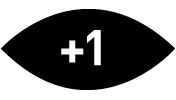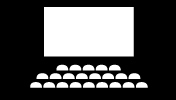

It's always thrilling to watch Stop Making Sense in a theater with a crowd, and whatever polishing was done for this new 4K transfer, the film is still the "same as it ever was!"
Often referred to as one of the greatest concert films of all time, I don't consider it hyperbole to state that this is the greatest concert movie ever made. It felt that way in 1984 when it was released, and I feel even more that way now. In fairness, the only other film that could claim that title is The Last Waltz, which I was also fortunate enough to see again in a cinema this year. In many ways, Martin Scorsese’s movie of The Band’s farewell performance at San Francisco's Winterland Ballroom on Thanksgiving Day 1976 packs a more significant emotional punch as a document of a historic musical event. But Stop Making Sense, which had the more modest ambition of merely trying to be a great concert movie, is the only such film I've seen that feels as cinematic as it does musical or theatrical.
Shot live over four nights at Hollywood's Pantages Theatre in December 1983, Jonathan Demme and the Talking Head's Stop Making Sense plays as if you're at the concert watching it live. The picture's flow is never interrupted by cutting backstage for reflections on the band's history like The Last Waltz does far too frequently. We get to know this band strictly through their music and how they present themselves on stage. Even if you're unfamiliar with the Talking Heads, and even if you don't particularly like their music, you get swept up in the energy of their performance. I experienced this the first time I saw the movie as a thirteen-year-old whose only awareness of Talking Heads was hearing the song "Once in a Lifetime" on the radio. No matter; I was mesmerized by the trailer and even more knocked out by the movie.
Three of the four Talking Heads (David Byrne, Chris Frantz, and Tina Weymouth) met at Rhode Island School of Design. They were not trained musicians who dreamed of forming a rock band; they were art students who collaborated on musical ideas that interested them as much as visual concepts did. They formed Talking Heads when they moved to New York City and joined up with Jerry Harrison, a member of the proto-punk band the Modern Lovers. The four were always an odd collection that looked out of place at the Mudd Club, CBGB, and the other punk venues they played. Byrne and Weymouth dressed in ways that accentuated anything unusual about their appearance, while Harrison dressed like the cool but straight-lased, Wisconsin-born, magna cum laude Harvard grad he was. Frantz's look could be described as goofball-preppy. Even in Stop Making Sense, Frantz arrives on stage looking like he's on his way to play squash, not to play drums for the greatest concert movie of all time.
To draw another comparison to The Last Waltz, The Band was responsible for essentially creating a new sub-genre of music: Americana. Talking Heads, on the other hand, represented a fusing of musical styles that were, up until that point, at odds with each other. The animosity between rock and disco in the late '70s and early '80s was so intense it could even lead to violence. The Talking Heads once played a nightclub where a large banner hung behind the stage proclaiming, "This Ain't No Disco!” The Heads liked disco but were amused by the phrase, borrowing it for one of their signature songs. While mainly categorized as a New Wave band, The Talking Heads explored diverse musical directions, from punk to electronica and other kinds of dance music, to psychedelic funk, African rhythms, white funkadelia, pop, disco, and what can only be described as straight-up rock 'n' roll. So, even though their music was unusual, it had broad appeal.
While many famous bands got their start at art schools, the graphic design background of three of these bandmates played a significant part in what made Talking Heads so musically distinctive. Their lyrics often come across like words pasted on a canvas for the interesting way they look to the eye. And their music sometimes features the instruments playing repetitive, unvarying riffs for the entirety of the song, which can induce a kind of trance-like groove. Their focus on the aesthetics of how things are framed, displayed, and illustrated within a context is also part of why this concert is so strikingly visual. They treat their songs almost as tactile objects and approach this stage show practically as an art installation.
ButStop Making Sense isn't just more visually dynamic than a typical concert film; it's also structured like a movie. It has almost all the narrative beats of a traditional Hollywood three-act story without an actual narrative. I suppose you could read frontman David Byrne's "character" as a typical uptight, straight, white businessman—appearing in various suits, including his iconic "big suit" that makes his head appear tiny— trapped in all the various roles, expectations, and limitations of an '80s misfit yuppie who undergoes multiple transformations and is eventually liberated by the power of music. But none of that is spelled out directly.
Instead, we get a deceptively straightforward narrative about how a show comes together. The film begins on a bare stage, and with each song, a new band member enters and takes their place. The set, gear, lighting, masking, and equipment get wheeled in and assembled piece by piece by roadies dressed in black while the band performs. As the Talking Heads slowly expand to include percussionist Steve Scales, backing vocalists Lynn Mabry and Ednah Holt, guitarist/vocalist Alex Weir, and keyboard player Bernie Worrell, the music becomes increasingly complex. After the whole band is assembled for a setpiece, "Burning Down the House," new visual concepts and "characters" are introduced and explored as the show progresses. It all builds to a cover of Al Green's "Take Me to the River," in which you feel you've undergone a spiritual transformation with the performers on stage. It's an incredibly simple and unpretentious structure, yet it provides a rock-solid framework that keeps the movie from ever feeling repetitive or dull.
The film explores multiple depictions of the human form as the performers bend, sway, and jerk, running in place, disappearing into shadows, and interacting with their clothing, instruments, and each other. Byrne's idiosyncratic, often spastic movements are offset by the fluidity and grace of the other musicians and the two backup singers. Everyone on stage is getting such a workout we're astonished that they can play with such precision and sing without losing their breath. Much of the show's visual aspects were conceived for the stage by Byrne, but the choreography grew out of improvised interactions between the band members while playing, which became formalized over the course of the tour. This designed and choreographed quality is another inverse of The Last Waltz, in which some of the most thrilling moments occur when Scorsese's cameras capture the subtle impromptu interplay between The Band and their iconic guest musicians. In unspoken mid-song communications, Bob Dylan or Eric Clapton will give Robbie Robertson or Levon Helm a look, communicating what should happen before the next verse or chord change. In Stop Making Sense, we see a carefully worked-out set in which each move, lighting cue, costume change, guitar, keyboard, and percussion solo (as well as the way the cameras capture it all) has been carefully worked out over many performances.
A great deal of credit for the success of Stop Making Sense must go to its director, Jonathan Demme. At the time, Demme had left Hollywood after an early stint as a B-movie director for the legendary producer Roger Corman (for whom he made the exploitation pictures Caged Heat, Crazy Mama, and Fighting Mad) followed by a string of studio pictures (Citizens Band, Last Embrace, and Melvin and Howard), which received wide critical acclaim but were not box-office hits. Demme then clashed creatively with Goldie Hawn, the star of his next film, Swing Shift, which caused him to doubt his abilities as a mainstream director. But he'd always been as interested in music as in filmmaking, and when the opportunity to document the show that Talking Heads developed during their Speaking in Tongues tour came up, he jumped at the chance.
Demme captures live performances on film better than any other director. I can't fully explain what he does that makes his concert films feel like they're happening to you in real-time—if anyone could break down Demme's magic, I'm sure many would be recording live events that way. But for another example, watch Swimming to Cambodia, Demme’s film of monologist Spalding Gray’s one-man show. Then watch Nick Broomfield’s film of Grey’s Monster in a Box and Steven Soderbergh’s film of Gray's Anatomy. All three are concert films made by major directors, but Demme's feels like a film, whereas Broomfield's and Soderbergh’s feel like live recordings made for HBO or Netflix. Or look at Spike Lee's excellent filmed version of David Byrne's recent concert tour, American Utopia, which is incredibly innovative but it still feels like watching a recording of a live event, not like being at one.
Another reason Stop Making Sense is such a singular concert film is simple timing. This tour occurred a little more than halfway through the band's sixteen-year run. But the setlist and the way the extended group's musicianship plays off each other makes the show feel like a career retrospective made, not at the end of a band's creative power and popularity, but at its apex. It was produced at a distinct point when brand-new digital technologies and hundred-year-old analog techniques were combined with extraordinary results. Cinematographer Jordan Cronenweth (Handle with Care, Altered States, Blade Runner) augmented the stage lighting design by Byrne and Beverly Emmons so it could be captured photochemically, but he stayed within Byrne and Emmons' concept of unfiltered lighting that maintained the native color of the tungsten or florescent lighting instruments. According to the band, the lighting design was far more effective in the movie than on stage because the limited latitude of the 35mm film made for stronger contrast than what the human eye would perceive. Also, Cronenweth could balance the slides projected behind the band with much greater precision than they'd achieve for live audiences, and the almost black-and-white color palette the band was going for pops on film in ways it never could live.
The concert was filmed with the standard cumbersome Panaflex cameras of the era, either hand-held or pushed on large dollies with cables trailing behind the operators and camera assistants to keep them in touch with Demme and Cronenweth. The camera crew wasn't exactly nimble, but they were well prepared regarding which shots each operator would try to capture each night. Their inability to be in all places at all times adds to the stripped-down, unostentatious aesthetic of the show. Demme and film editor Lisa Day cut from shot to shot in a manner intended to reveal the various band members' "characters" rather than merely cutting to whoever took a solo or a featured moment in a song. This editorial style also adds to the sense that we're watching a movie about people as well as a documentary about a musical event.
The footage was gathered with seven cameras over three nights (since the first night was mostly awash because Cronenweth's initial decision to light the audience messed with the band's energy and their interactions with the crowd to the point where no one was happy with the performance). The second night, they shot with all the cameras on the left of the stage, the third with all the cameras on the right, and the final night they shot head-on. The idea was that the camera crew wouldn't be seen in each other's shots. Whenever a stray operator is visible in a frame, they feel like part of the road crew constantly changing the stage and lighting. Demme, Cronenweth, and Day give each of the sixteen songs a distinctive look. The differences are subtle, but no two songs are shot or cut the same way, which is a principal reason why, even if you're unfamiliar with the music, the film never becomes dull or repetitive.
The fact that the movie was shot and recorded over multiple nights with no one playing to a click-track and no pre-recorded elements employed (apart from the drum loop Byrne plays solo to in the opening number Psycho Killer) means that not all the footage syncs up perfectly with the music in every shot. The concert was recorded with then-state-of-the-art 24-track digital sound equipment, which enabled easier blending of tracks from different performances. The band also recorded some overdubs of non-percussion instruments to enable closer finger sync in certain places. The film was the first ever recorded entirely with digital audio, and it ushered in a new era of sound for music movies. But it was made in the decade before bands and solo artists routinely started performing live to pre-recorded playback tracks or using custom earpieces with specific mixes for each band member. It is impossible to achieve the kind of raw abandon this group plays with if each performer is listening to their own mix or playing slavishly to a pre-determined tempo.
So the picture and sound in this movie may not always line up perfectly, but whenever I catch a glimpse of Frantz putting the can of a headphone to his ear and listening to a metronome for a couple of seconds before starting to play a song, I'm reminded that this is the only technique used in this film to get each song as close to the same tempo each night as humanly possible, and my admiration for the skill of these musicians increases all the more. The changes in live performance technology, which have enabled people with little musical talent to become major pop stars, came into everyday use only six or seven years after this film was released. That this film was made within a tiny window of time when new and old technology worked in concert so harmoniously is yet another reason it's so damn special.
Stop Making Sense was reissued for its fifteenth anniversary and is now back in theaters in 4K and digital IMAX. It would be insane to miss this run. See it in as loud a theater as you possibly can!!!!
(4K-cinema)
Jonathan Demme and Talking Heads create the greatest concert film of all time. The combination of visual and narrative aesthetics, digital and analog technologies, and unique timing resulted in a career retrospective occurring at the apex of a band's creative output & popularity rather than at its end.









